A Study on the Effects of Mobile Radiation on Human Health: Report
VerifiedAdded on 2022/09/29
|13
|2702
|46
Report
AI Summary
This report presents a study on the effects of mobile radiation on human health, focusing on a sample population in Portsmouth. The research investigates the awareness of individuals regarding the potential health risks associated with mobile phone usage. The study employed a quantitative research design, utilizing street and online surveys to gather data on participants' mobile phone usage habits and their perceptions of radiation's impact. Key findings revealed that while a majority of participants acknowledged the negative health effects of mobile radiation, many lacked a comprehensive understanding of the risks. The report discusses the relationship between mobile usage time and health concerns, highlighting the need for further research and public awareness campaigns to mitigate the potential adverse health consequences of mobile phone use. The research also explores the limitations of the study, such as convenience sampling, and suggests areas for future investigation.
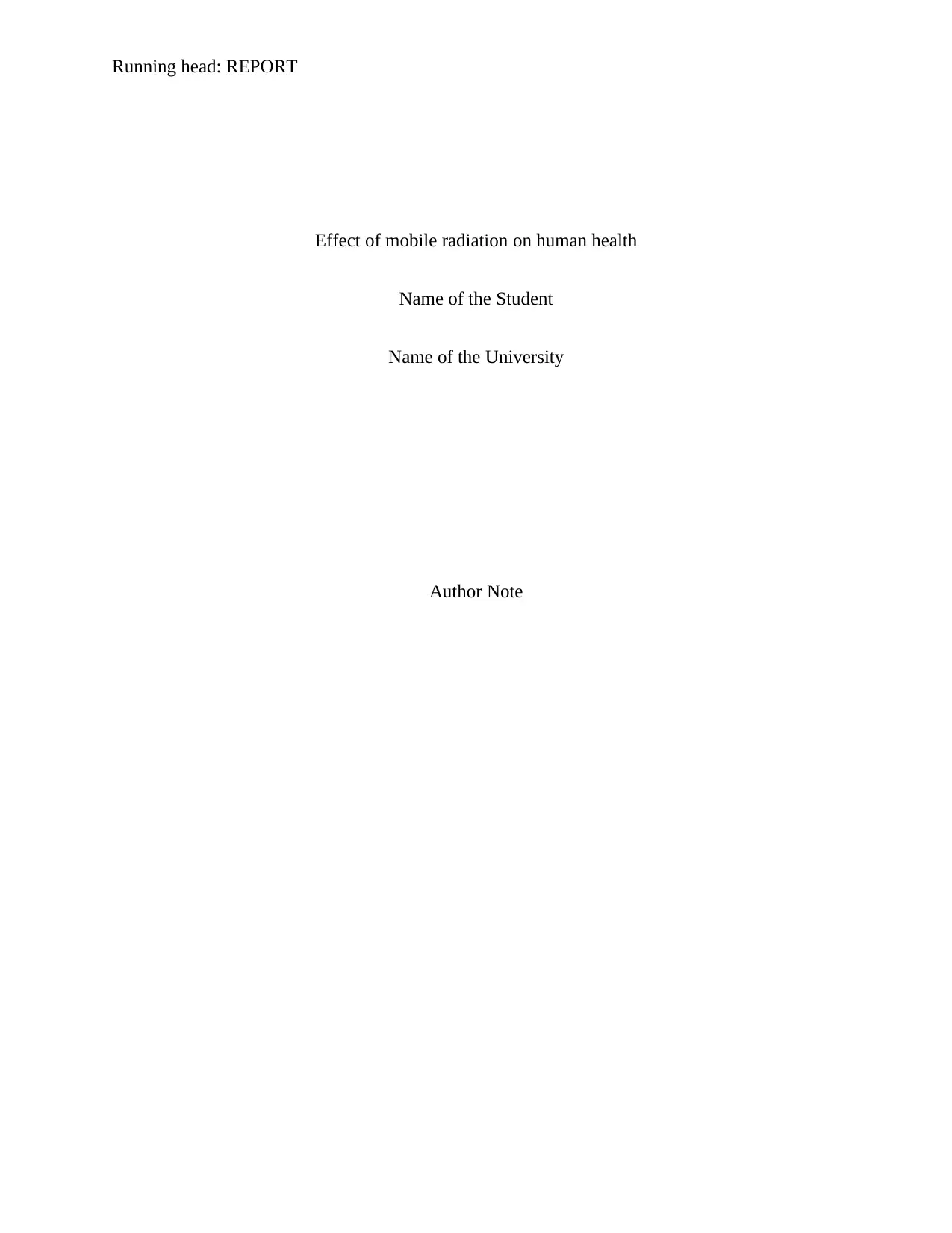
Running head: REPORT
Effect of mobile radiation on human health
Name of the Student
Name of the University
Author Note
Effect of mobile radiation on human health
Name of the Student
Name of the University
Author Note
Paraphrase This Document
Need a fresh take? Get an instant paraphrase of this document with our AI Paraphraser
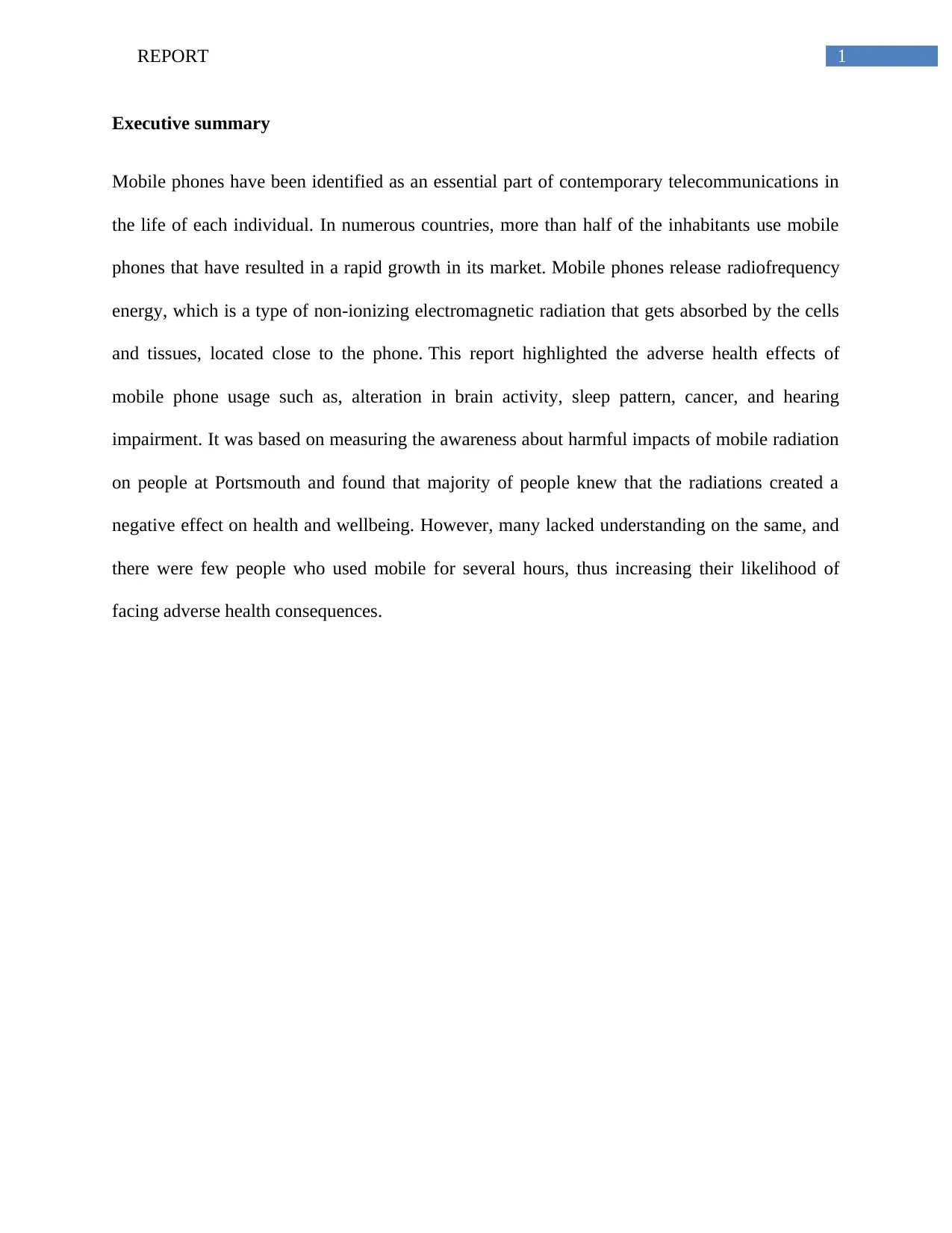
1REPORT
Executive summary
Mobile phones have been identified as an essential part of contemporary telecommunications in
the life of each individual. In numerous countries, more than half of the inhabitants use mobile
phones that have resulted in a rapid growth in its market. Mobile phones release radiofrequency
energy, which is a type of non-ionizing electromagnetic radiation that gets absorbed by the cells
and tissues, located close to the phone. This report highlighted the adverse health effects of
mobile phone usage such as, alteration in brain activity, sleep pattern, cancer, and hearing
impairment. It was based on measuring the awareness about harmful impacts of mobile radiation
on people at Portsmouth and found that majority of people knew that the radiations created a
negative effect on health and wellbeing. However, many lacked understanding on the same, and
there were few people who used mobile for several hours, thus increasing their likelihood of
facing adverse health consequences.
Executive summary
Mobile phones have been identified as an essential part of contemporary telecommunications in
the life of each individual. In numerous countries, more than half of the inhabitants use mobile
phones that have resulted in a rapid growth in its market. Mobile phones release radiofrequency
energy, which is a type of non-ionizing electromagnetic radiation that gets absorbed by the cells
and tissues, located close to the phone. This report highlighted the adverse health effects of
mobile phone usage such as, alteration in brain activity, sleep pattern, cancer, and hearing
impairment. It was based on measuring the awareness about harmful impacts of mobile radiation
on people at Portsmouth and found that majority of people knew that the radiations created a
negative effect on health and wellbeing. However, many lacked understanding on the same, and
there were few people who used mobile for several hours, thus increasing their likelihood of
facing adverse health consequences.
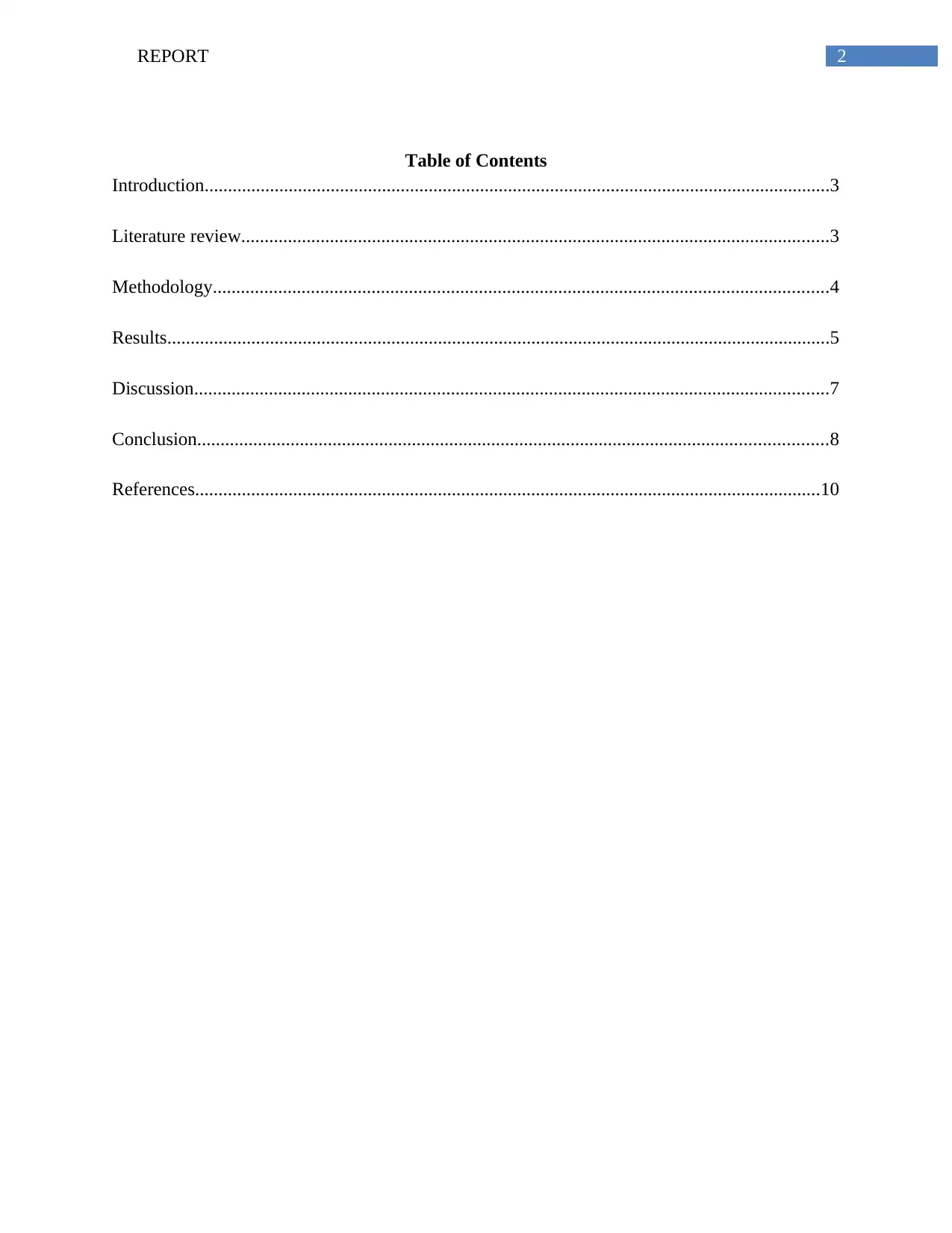
2REPORT
Table of Contents
Introduction......................................................................................................................................3
Literature review..............................................................................................................................3
Methodology....................................................................................................................................4
Results..............................................................................................................................................5
Discussion........................................................................................................................................7
Conclusion.......................................................................................................................................8
References......................................................................................................................................10
Table of Contents
Introduction......................................................................................................................................3
Literature review..............................................................................................................................3
Methodology....................................................................................................................................4
Results..............................................................................................................................................5
Discussion........................................................................................................................................7
Conclusion.......................................................................................................................................8
References......................................................................................................................................10
⊘ This is a preview!⊘
Do you want full access?
Subscribe today to unlock all pages.

Trusted by 1+ million students worldwide
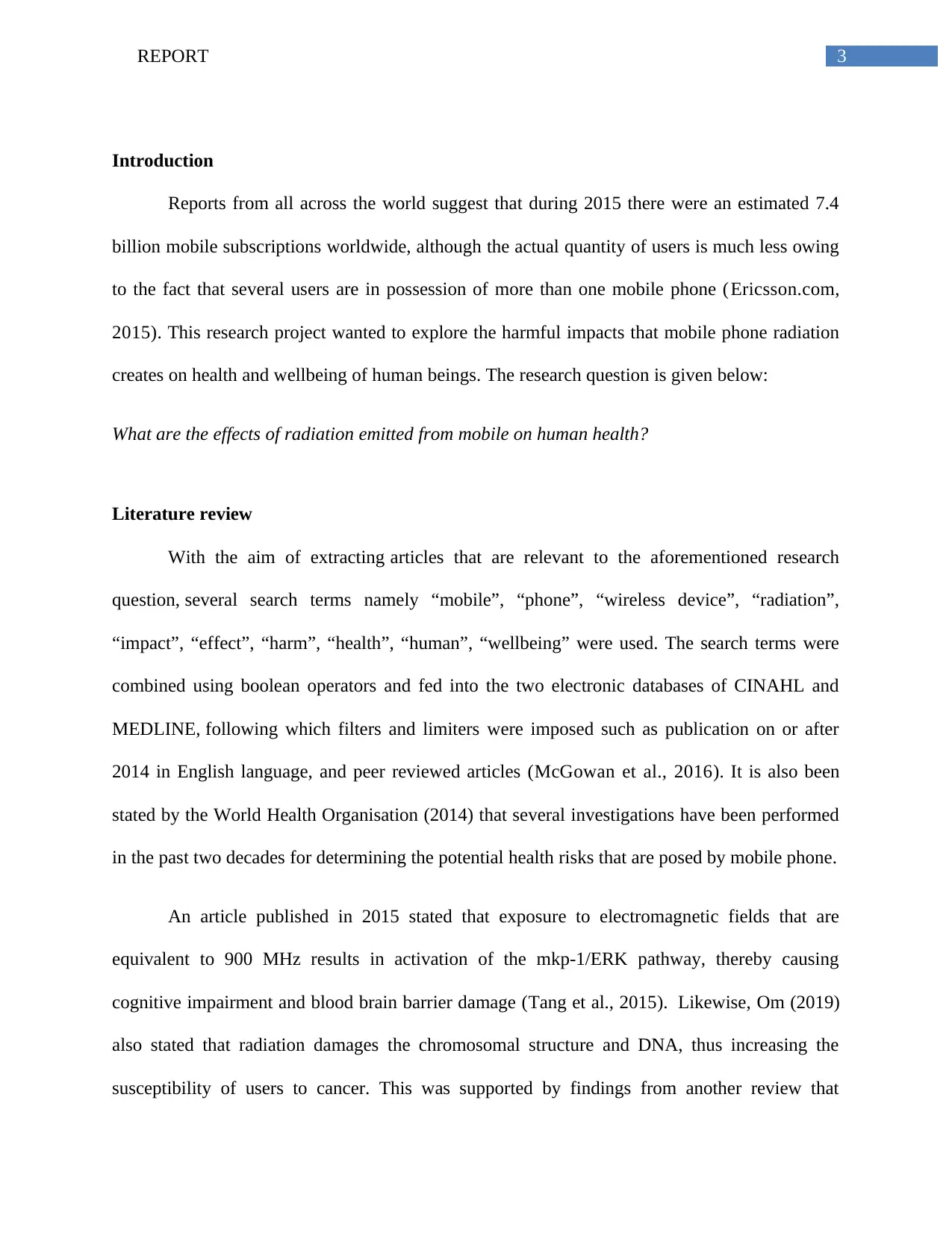
3REPORT
Introduction
Reports from all across the world suggest that during 2015 there were an estimated 7.4
billion mobile subscriptions worldwide, although the actual quantity of users is much less owing
to the fact that several users are in possession of more than one mobile phone (Ericsson.com,
2015). This research project wanted to explore the harmful impacts that mobile phone radiation
creates on health and wellbeing of human beings. The research question is given below:
What are the effects of radiation emitted from mobile on human health?
Literature review
With the aim of extracting articles that are relevant to the aforementioned research
question, several search terms namely “mobile”, “phone”, “wireless device”, “radiation”,
“impact”, “effect”, “harm”, “health”, “human”, “wellbeing” were used. The search terms were
combined using boolean operators and fed into the two electronic databases of CINAHL and
MEDLINE, following which filters and limiters were imposed such as publication on or after
2014 in English language, and peer reviewed articles (McGowan et al., 2016). It is also been
stated by the World Health Organisation (2014) that several investigations have been performed
in the past two decades for determining the potential health risks that are posed by mobile phone.
An article published in 2015 stated that exposure to electromagnetic fields that are
equivalent to 900 MHz results in activation of the mkp-1/ERK pathway, thereby causing
cognitive impairment and blood brain barrier damage (Tang et al., 2015). Likewise, Om (2019)
also stated that radiation damages the chromosomal structure and DNA, thus increasing the
susceptibility of users to cancer. This was supported by findings from another review that
Introduction
Reports from all across the world suggest that during 2015 there were an estimated 7.4
billion mobile subscriptions worldwide, although the actual quantity of users is much less owing
to the fact that several users are in possession of more than one mobile phone (Ericsson.com,
2015). This research project wanted to explore the harmful impacts that mobile phone radiation
creates on health and wellbeing of human beings. The research question is given below:
What are the effects of radiation emitted from mobile on human health?
Literature review
With the aim of extracting articles that are relevant to the aforementioned research
question, several search terms namely “mobile”, “phone”, “wireless device”, “radiation”,
“impact”, “effect”, “harm”, “health”, “human”, “wellbeing” were used. The search terms were
combined using boolean operators and fed into the two electronic databases of CINAHL and
MEDLINE, following which filters and limiters were imposed such as publication on or after
2014 in English language, and peer reviewed articles (McGowan et al., 2016). It is also been
stated by the World Health Organisation (2014) that several investigations have been performed
in the past two decades for determining the potential health risks that are posed by mobile phone.
An article published in 2015 stated that exposure to electromagnetic fields that are
equivalent to 900 MHz results in activation of the mkp-1/ERK pathway, thereby causing
cognitive impairment and blood brain barrier damage (Tang et al., 2015). Likewise, Om (2019)
also stated that radiation damages the chromosomal structure and DNA, thus increasing the
susceptibility of users to cancer. This was supported by findings from another review that
Paraphrase This Document
Need a fresh take? Get an instant paraphrase of this document with our AI Paraphraser
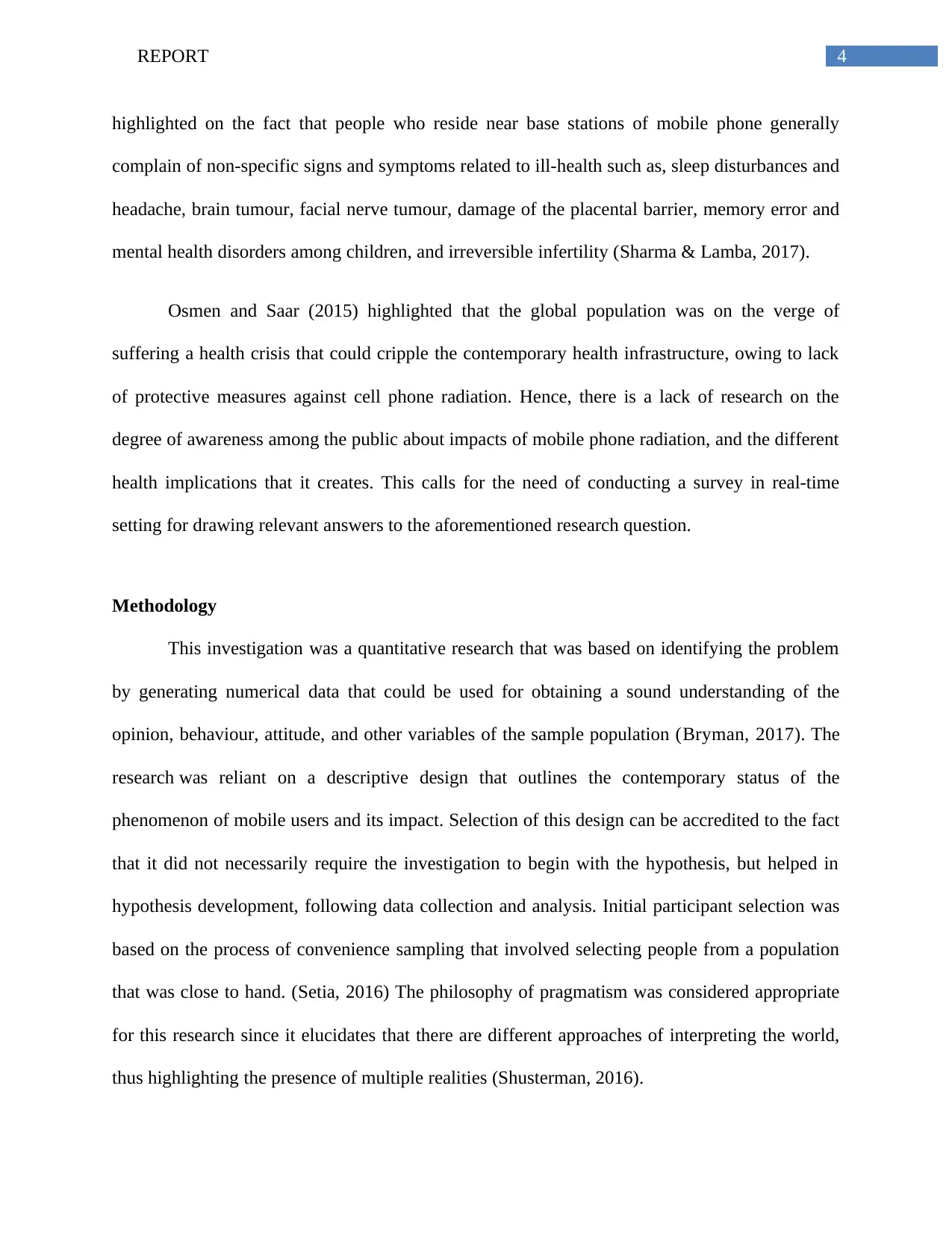
4REPORT
highlighted on the fact that people who reside near base stations of mobile phone generally
complain of non-specific signs and symptoms related to ill-health such as, sleep disturbances and
headache, brain tumour, facial nerve tumour, damage of the placental barrier, memory error and
mental health disorders among children, and irreversible infertility (Sharma & Lamba, 2017).
Osmen and Saar (2015) highlighted that the global population was on the verge of
suffering a health crisis that could cripple the contemporary health infrastructure, owing to lack
of protective measures against cell phone radiation. Hence, there is a lack of research on the
degree of awareness among the public about impacts of mobile phone radiation, and the different
health implications that it creates. This calls for the need of conducting a survey in real-time
setting for drawing relevant answers to the aforementioned research question.
Methodology
This investigation was a quantitative research that was based on identifying the problem
by generating numerical data that could be used for obtaining a sound understanding of the
opinion, behaviour, attitude, and other variables of the sample population (Bryman, 2017). The
research was reliant on a descriptive design that outlines the contemporary status of the
phenomenon of mobile users and its impact. Selection of this design can be accredited to the fact
that it did not necessarily require the investigation to begin with the hypothesis, but helped in
hypothesis development, following data collection and analysis. Initial participant selection was
based on the process of convenience sampling that involved selecting people from a population
that was close to hand. (Setia, 2016) The philosophy of pragmatism was considered appropriate
for this research since it elucidates that there are different approaches of interpreting the world,
thus highlighting the presence of multiple realities (Shusterman, 2016).
highlighted on the fact that people who reside near base stations of mobile phone generally
complain of non-specific signs and symptoms related to ill-health such as, sleep disturbances and
headache, brain tumour, facial nerve tumour, damage of the placental barrier, memory error and
mental health disorders among children, and irreversible infertility (Sharma & Lamba, 2017).
Osmen and Saar (2015) highlighted that the global population was on the verge of
suffering a health crisis that could cripple the contemporary health infrastructure, owing to lack
of protective measures against cell phone radiation. Hence, there is a lack of research on the
degree of awareness among the public about impacts of mobile phone radiation, and the different
health implications that it creates. This calls for the need of conducting a survey in real-time
setting for drawing relevant answers to the aforementioned research question.
Methodology
This investigation was a quantitative research that was based on identifying the problem
by generating numerical data that could be used for obtaining a sound understanding of the
opinion, behaviour, attitude, and other variables of the sample population (Bryman, 2017). The
research was reliant on a descriptive design that outlines the contemporary status of the
phenomenon of mobile users and its impact. Selection of this design can be accredited to the fact
that it did not necessarily require the investigation to begin with the hypothesis, but helped in
hypothesis development, following data collection and analysis. Initial participant selection was
based on the process of convenience sampling that involved selecting people from a population
that was close to hand. (Setia, 2016) The philosophy of pragmatism was considered appropriate
for this research since it elucidates that there are different approaches of interpreting the world,
thus highlighting the presence of multiple realities (Shusterman, 2016).
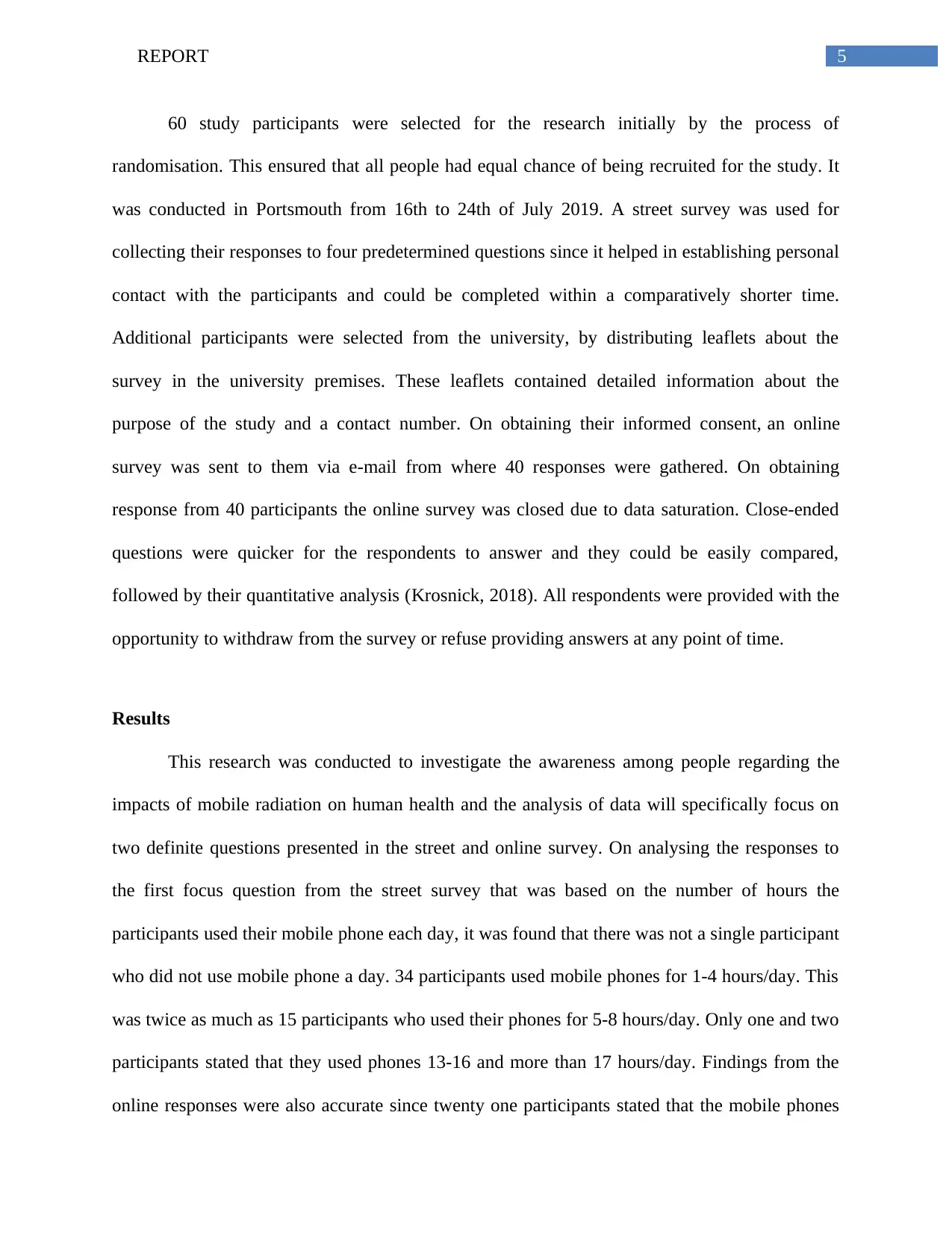
5REPORT
60 study participants were selected for the research initially by the process of
randomisation. This ensured that all people had equal chance of being recruited for the study. It
was conducted in Portsmouth from 16th to 24th of July 2019. A street survey was used for
collecting their responses to four predetermined questions since it helped in establishing personal
contact with the participants and could be completed within a comparatively shorter time.
Additional participants were selected from the university, by distributing leaflets about the
survey in the university premises. These leaflets contained detailed information about the
purpose of the study and a contact number. On obtaining their informed consent, an online
survey was sent to them via e-mail from where 40 responses were gathered. On obtaining
response from 40 participants the online survey was closed due to data saturation. Close-ended
questions were quicker for the respondents to answer and they could be easily compared,
followed by their quantitative analysis (Krosnick, 2018). All respondents were provided with the
opportunity to withdraw from the survey or refuse providing answers at any point of time.
Results
This research was conducted to investigate the awareness among people regarding the
impacts of mobile radiation on human health and the analysis of data will specifically focus on
two definite questions presented in the street and online survey. On analysing the responses to
the first focus question from the street survey that was based on the number of hours the
participants used their mobile phone each day, it was found that there was not a single participant
who did not use mobile phone a day. 34 participants used mobile phones for 1-4 hours/day. This
was twice as much as 15 participants who used their phones for 5-8 hours/day. Only one and two
participants stated that they used phones 13-16 and more than 17 hours/day. Findings from the
online responses were also accurate since twenty one participants stated that the mobile phones
60 study participants were selected for the research initially by the process of
randomisation. This ensured that all people had equal chance of being recruited for the study. It
was conducted in Portsmouth from 16th to 24th of July 2019. A street survey was used for
collecting their responses to four predetermined questions since it helped in establishing personal
contact with the participants and could be completed within a comparatively shorter time.
Additional participants were selected from the university, by distributing leaflets about the
survey in the university premises. These leaflets contained detailed information about the
purpose of the study and a contact number. On obtaining their informed consent, an online
survey was sent to them via e-mail from where 40 responses were gathered. On obtaining
response from 40 participants the online survey was closed due to data saturation. Close-ended
questions were quicker for the respondents to answer and they could be easily compared,
followed by their quantitative analysis (Krosnick, 2018). All respondents were provided with the
opportunity to withdraw from the survey or refuse providing answers at any point of time.
Results
This research was conducted to investigate the awareness among people regarding the
impacts of mobile radiation on human health and the analysis of data will specifically focus on
two definite questions presented in the street and online survey. On analysing the responses to
the first focus question from the street survey that was based on the number of hours the
participants used their mobile phone each day, it was found that there was not a single participant
who did not use mobile phone a day. 34 participants used mobile phones for 1-4 hours/day. This
was twice as much as 15 participants who used their phones for 5-8 hours/day. Only one and two
participants stated that they used phones 13-16 and more than 17 hours/day. Findings from the
online responses were also accurate since twenty one participants stated that the mobile phones
⊘ This is a preview!⊘
Do you want full access?
Subscribe today to unlock all pages.

Trusted by 1+ million students worldwide
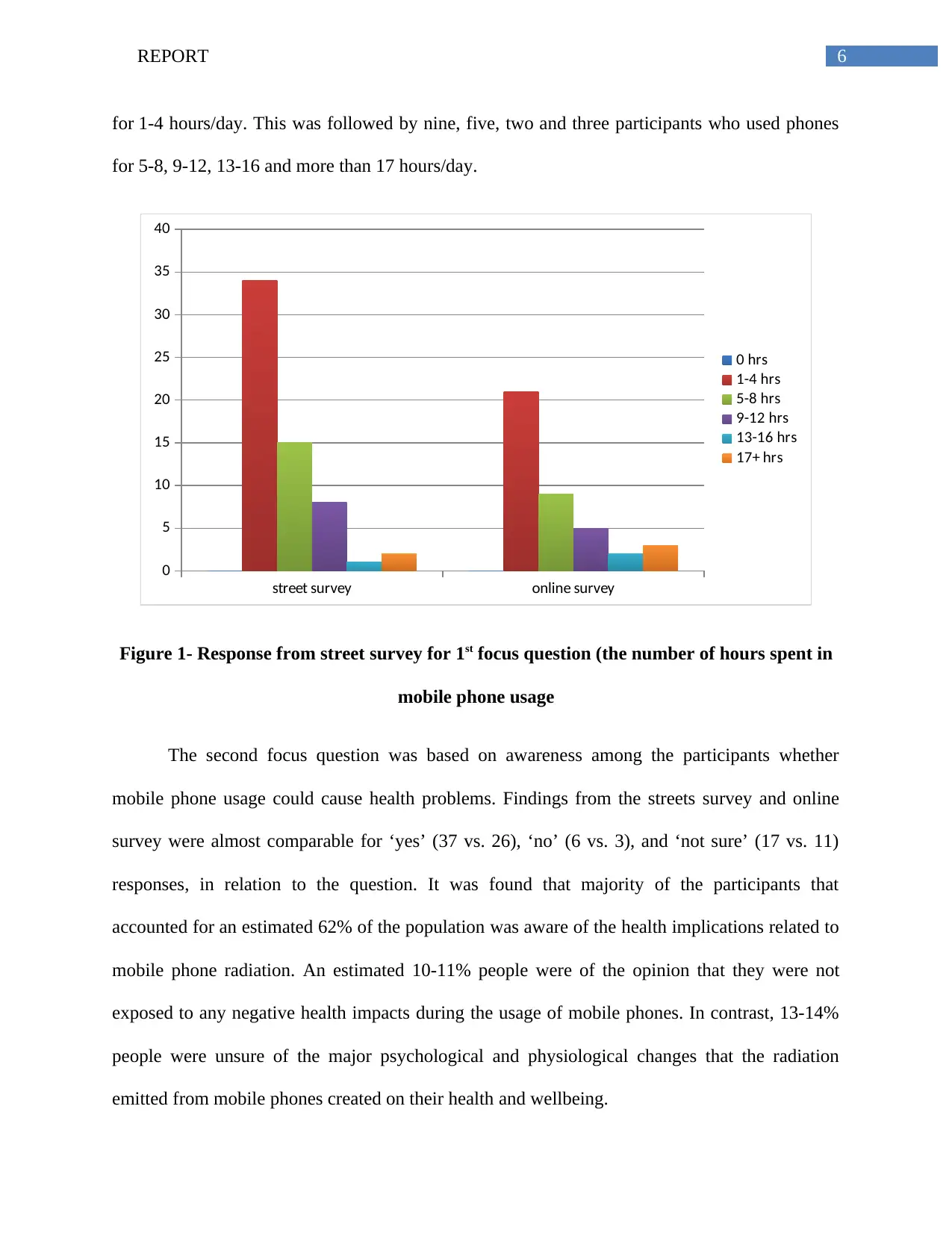
6REPORT
for 1-4 hours/day. This was followed by nine, five, two and three participants who used phones
for 5-8, 9-12, 13-16 and more than 17 hours/day.
street survey online survey
0
5
10
15
20
25
30
35
40
0 hrs
1-4 hrs
5-8 hrs
9-12 hrs
13-16 hrs
17+ hrs
Figure 1- Response from street survey for 1st focus question (the number of hours spent in
mobile phone usage
The second focus question was based on awareness among the participants whether
mobile phone usage could cause health problems. Findings from the streets survey and online
survey were almost comparable for ‘yes’ (37 vs. 26), ‘no’ (6 vs. 3), and ‘not sure’ (17 vs. 11)
responses, in relation to the question. It was found that majority of the participants that
accounted for an estimated 62% of the population was aware of the health implications related to
mobile phone radiation. An estimated 10-11% people were of the opinion that they were not
exposed to any negative health impacts during the usage of mobile phones. In contrast, 13-14%
people were unsure of the major psychological and physiological changes that the radiation
emitted from mobile phones created on their health and wellbeing.
for 1-4 hours/day. This was followed by nine, five, two and three participants who used phones
for 5-8, 9-12, 13-16 and more than 17 hours/day.
street survey online survey
0
5
10
15
20
25
30
35
40
0 hrs
1-4 hrs
5-8 hrs
9-12 hrs
13-16 hrs
17+ hrs
Figure 1- Response from street survey for 1st focus question (the number of hours spent in
mobile phone usage
The second focus question was based on awareness among the participants whether
mobile phone usage could cause health problems. Findings from the streets survey and online
survey were almost comparable for ‘yes’ (37 vs. 26), ‘no’ (6 vs. 3), and ‘not sure’ (17 vs. 11)
responses, in relation to the question. It was found that majority of the participants that
accounted for an estimated 62% of the population was aware of the health implications related to
mobile phone radiation. An estimated 10-11% people were of the opinion that they were not
exposed to any negative health impacts during the usage of mobile phones. In contrast, 13-14%
people were unsure of the major psychological and physiological changes that the radiation
emitted from mobile phones created on their health and wellbeing.
Paraphrase This Document
Need a fresh take? Get an instant paraphrase of this document with our AI Paraphraser
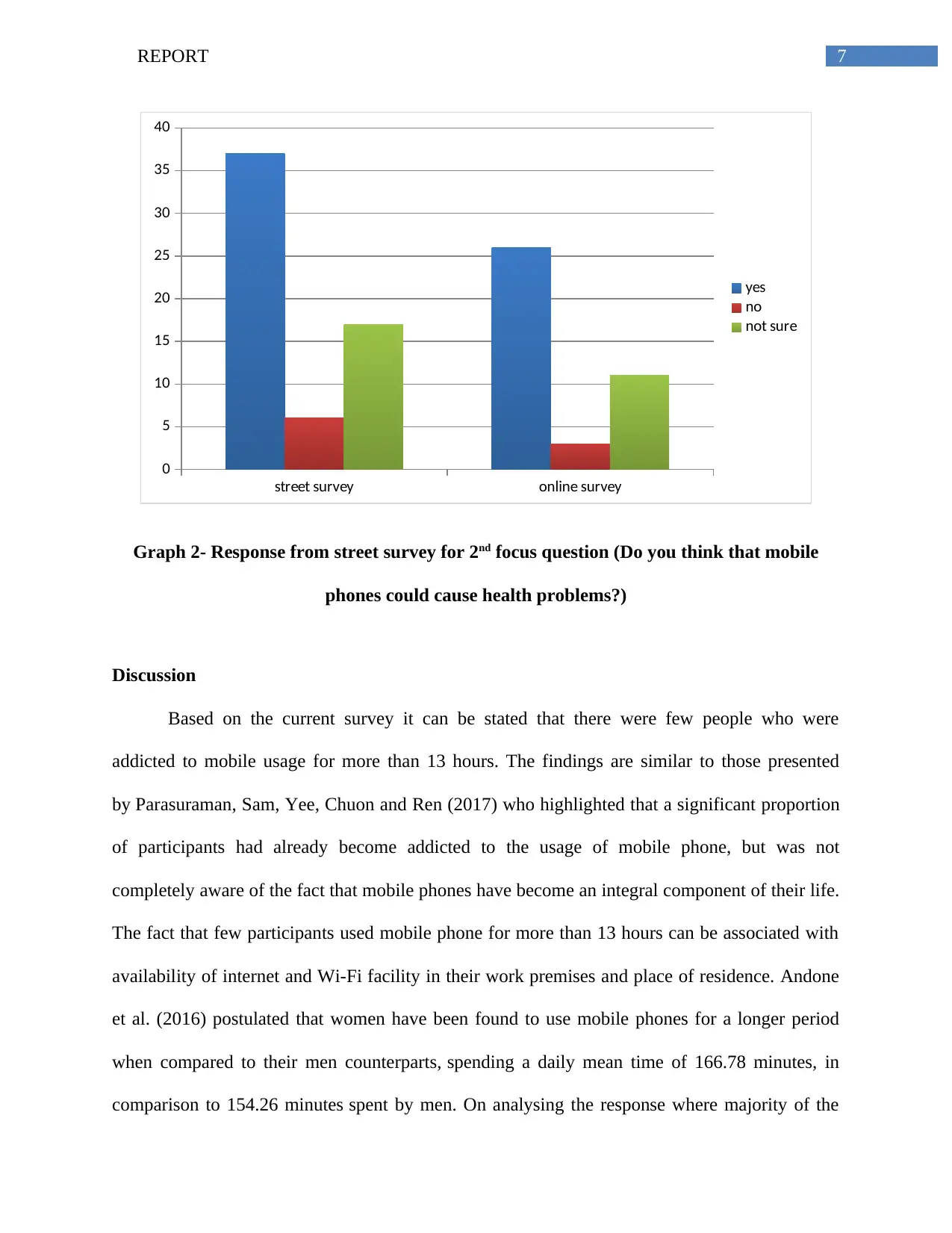
7REPORT
street survey online survey
0
5
10
15
20
25
30
35
40
yes
no
not sure
Graph 2- Response from street survey for 2nd focus question (Do you think that mobile
phones could cause health problems?)
Discussion
Based on the current survey it can be stated that there were few people who were
addicted to mobile usage for more than 13 hours. The findings are similar to those presented
by Parasuraman, Sam, Yee, Chuon and Ren (2017) who highlighted that a significant proportion
of participants had already become addicted to the usage of mobile phone, but was not
completely aware of the fact that mobile phones have become an integral component of their life.
The fact that few participants used mobile phone for more than 13 hours can be associated with
availability of internet and Wi-Fi facility in their work premises and place of residence. Andone
et al. (2016) postulated that women have been found to use mobile phones for a longer period
when compared to their men counterparts, spending a daily mean time of 166.78 minutes, in
comparison to 154.26 minutes spent by men. On analysing the response where majority of the
street survey online survey
0
5
10
15
20
25
30
35
40
yes
no
not sure
Graph 2- Response from street survey for 2nd focus question (Do you think that mobile
phones could cause health problems?)
Discussion
Based on the current survey it can be stated that there were few people who were
addicted to mobile usage for more than 13 hours. The findings are similar to those presented
by Parasuraman, Sam, Yee, Chuon and Ren (2017) who highlighted that a significant proportion
of participants had already become addicted to the usage of mobile phone, but was not
completely aware of the fact that mobile phones have become an integral component of their life.
The fact that few participants used mobile phone for more than 13 hours can be associated with
availability of internet and Wi-Fi facility in their work premises and place of residence. Andone
et al. (2016) postulated that women have been found to use mobile phones for a longer period
when compared to their men counterparts, spending a daily mean time of 166.78 minutes, in
comparison to 154.26 minutes spent by men. On analysing the response where majority of the
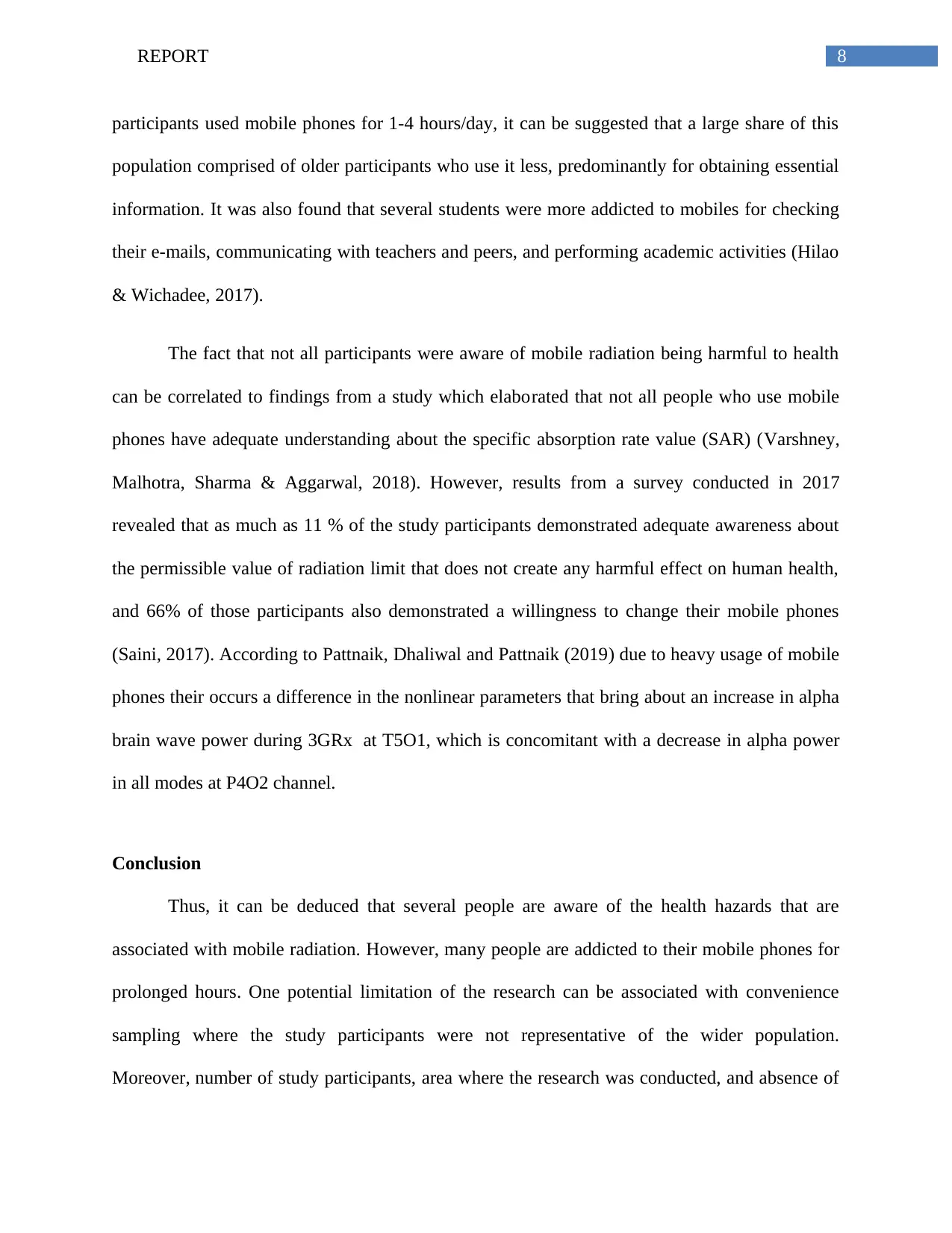
8REPORT
participants used mobile phones for 1-4 hours/day, it can be suggested that a large share of this
population comprised of older participants who use it less, predominantly for obtaining essential
information. It was also found that several students were more addicted to mobiles for checking
their e-mails, communicating with teachers and peers, and performing academic activities (Hilao
& Wichadee, 2017).
The fact that not all participants were aware of mobile radiation being harmful to health
can be correlated to findings from a study which elaborated that not all people who use mobile
phones have adequate understanding about the specific absorption rate value (SAR) (Varshney,
Malhotra, Sharma & Aggarwal, 2018). However, results from a survey conducted in 2017
revealed that as much as 11 % of the study participants demonstrated adequate awareness about
the permissible value of radiation limit that does not create any harmful effect on human health,
and 66% of those participants also demonstrated a willingness to change their mobile phones
(Saini, 2017). According to Pattnaik, Dhaliwal and Pattnaik (2019) due to heavy usage of mobile
phones their occurs a difference in the nonlinear parameters that bring about an increase in alpha
brain wave power during 3GRx at T5O1, which is concomitant with a decrease in alpha power
in all modes at P4O2 channel.
Conclusion
Thus, it can be deduced that several people are aware of the health hazards that are
associated with mobile radiation. However, many people are addicted to their mobile phones for
prolonged hours. One potential limitation of the research can be associated with convenience
sampling where the study participants were not representative of the wider population.
Moreover, number of study participants, area where the research was conducted, and absence of
participants used mobile phones for 1-4 hours/day, it can be suggested that a large share of this
population comprised of older participants who use it less, predominantly for obtaining essential
information. It was also found that several students were more addicted to mobiles for checking
their e-mails, communicating with teachers and peers, and performing academic activities (Hilao
& Wichadee, 2017).
The fact that not all participants were aware of mobile radiation being harmful to health
can be correlated to findings from a study which elaborated that not all people who use mobile
phones have adequate understanding about the specific absorption rate value (SAR) (Varshney,
Malhotra, Sharma & Aggarwal, 2018). However, results from a survey conducted in 2017
revealed that as much as 11 % of the study participants demonstrated adequate awareness about
the permissible value of radiation limit that does not create any harmful effect on human health,
and 66% of those participants also demonstrated a willingness to change their mobile phones
(Saini, 2017). According to Pattnaik, Dhaliwal and Pattnaik (2019) due to heavy usage of mobile
phones their occurs a difference in the nonlinear parameters that bring about an increase in alpha
brain wave power during 3GRx at T5O1, which is concomitant with a decrease in alpha power
in all modes at P4O2 channel.
Conclusion
Thus, it can be deduced that several people are aware of the health hazards that are
associated with mobile radiation. However, many people are addicted to their mobile phones for
prolonged hours. One potential limitation of the research can be associated with convenience
sampling where the study participants were not representative of the wider population.
Moreover, number of study participants, area where the research was conducted, and absence of
⊘ This is a preview!⊘
Do you want full access?
Subscribe today to unlock all pages.

Trusted by 1+ million students worldwide

9REPORT
any open-ended questions acted as significant limitations, thereby introducing bias in the
research results. This calls for the need of conducting a study on a larger sample size that will be
collected from a wider population in future.
any open-ended questions acted as significant limitations, thereby introducing bias in the
research results. This calls for the need of conducting a study on a larger sample size that will be
collected from a wider population in future.
Paraphrase This Document
Need a fresh take? Get an instant paraphrase of this document with our AI Paraphraser
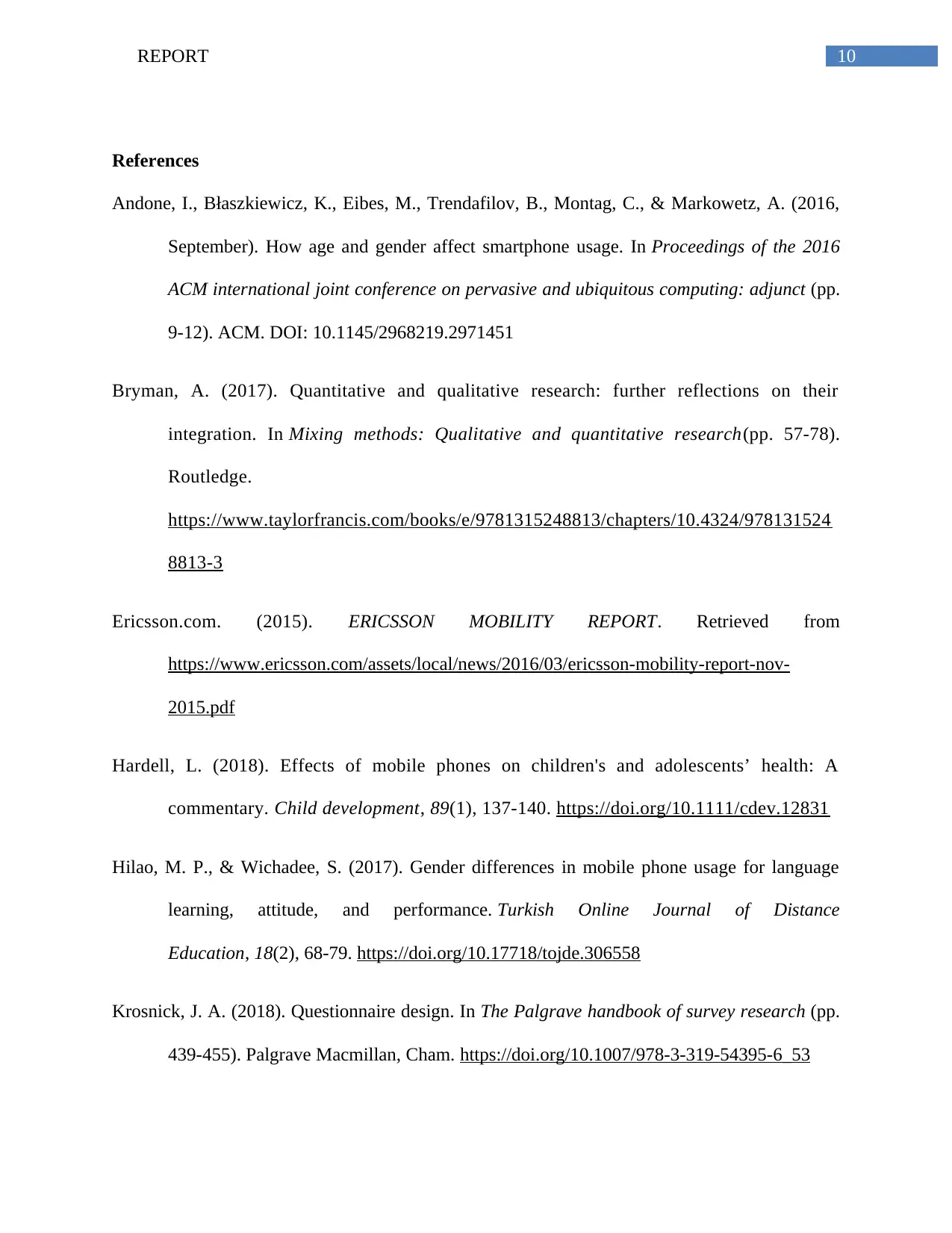
10REPORT
References
Andone, I., Błaszkiewicz, K., Eibes, M., Trendafilov, B., Montag, C., & Markowetz, A. (2016,
September). How age and gender affect smartphone usage. In Proceedings of the 2016
ACM international joint conference on pervasive and ubiquitous computing: adjunct (pp.
9-12). ACM. DOI: 10.1145/2968219.2971451
Bryman, A. (2017). Quantitative and qualitative research: further reflections on their
integration. In Mixing methods: Qualitative and quantitative research(pp. 57-78).
Routledge.
https://www.taylorfrancis.com/books/e/9781315248813/chapters/10.4324/978131524
8813-3
Ericsson.com. (2015). ERICSSON MOBILITY REPORT. Retrieved from
https://www.ericsson.com/assets/local/news/2016/03/ericsson-mobility-report-nov-
2015.pdf
Hardell, L. (2018). Effects of mobile phones on children's and adolescents’ health: A
commentary. Child development, 89(1), 137-140. https://doi.org/10.1111/cdev.12831
Hilao, M. P., & Wichadee, S. (2017). Gender differences in mobile phone usage for language
learning, attitude, and performance. Turkish Online Journal of Distance
Education, 18(2), 68-79. https://doi.org/10.17718/tojde.306558
Krosnick, J. A. (2018). Questionnaire design. In The Palgrave handbook of survey research (pp.
439-455). Palgrave Macmillan, Cham. https://doi.org/10.1007/978-3-319-54395-6_53
References
Andone, I., Błaszkiewicz, K., Eibes, M., Trendafilov, B., Montag, C., & Markowetz, A. (2016,
September). How age and gender affect smartphone usage. In Proceedings of the 2016
ACM international joint conference on pervasive and ubiquitous computing: adjunct (pp.
9-12). ACM. DOI: 10.1145/2968219.2971451
Bryman, A. (2017). Quantitative and qualitative research: further reflections on their
integration. In Mixing methods: Qualitative and quantitative research(pp. 57-78).
Routledge.
https://www.taylorfrancis.com/books/e/9781315248813/chapters/10.4324/978131524
8813-3
Ericsson.com. (2015). ERICSSON MOBILITY REPORT. Retrieved from
https://www.ericsson.com/assets/local/news/2016/03/ericsson-mobility-report-nov-
2015.pdf
Hardell, L. (2018). Effects of mobile phones on children's and adolescents’ health: A
commentary. Child development, 89(1), 137-140. https://doi.org/10.1111/cdev.12831
Hilao, M. P., & Wichadee, S. (2017). Gender differences in mobile phone usage for language
learning, attitude, and performance. Turkish Online Journal of Distance
Education, 18(2), 68-79. https://doi.org/10.17718/tojde.306558
Krosnick, J. A. (2018). Questionnaire design. In The Palgrave handbook of survey research (pp.
439-455). Palgrave Macmillan, Cham. https://doi.org/10.1007/978-3-319-54395-6_53
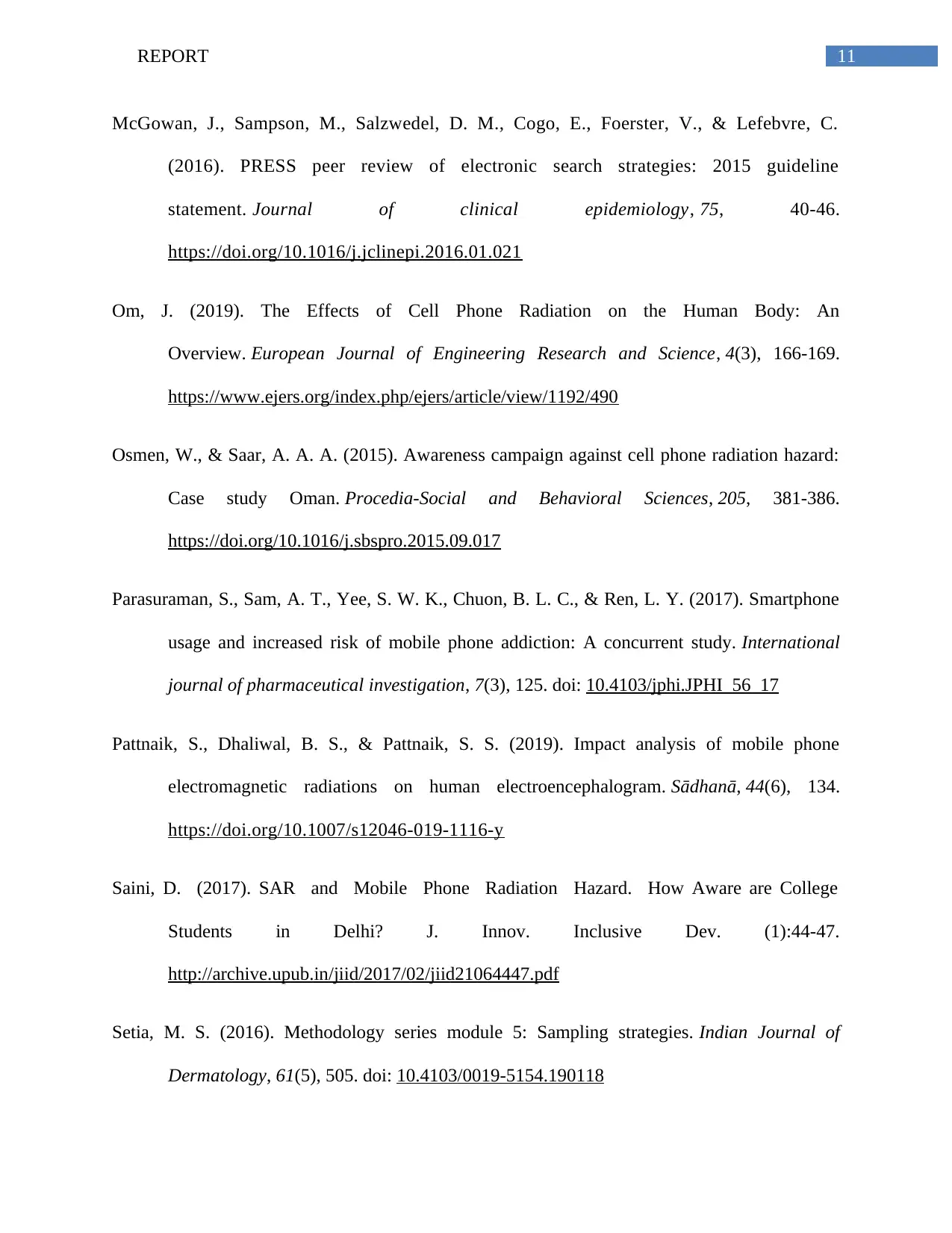
11REPORT
McGowan, J., Sampson, M., Salzwedel, D. M., Cogo, E., Foerster, V., & Lefebvre, C.
(2016). PRESS peer review of electronic search strategies: 2015 guideline
statement. Journal of clinical epidemiology, 75, 40-46.
https://doi.org/10.1016/j.jclinepi.2016.01.021
Om, J. (2019). The Effects of Cell Phone Radiation on the Human Body: An
Overview. European Journal of Engineering Research and Science, 4(3), 166-169.
https://www.ejers.org/index.php/ejers/article/view/1192/490
Osmen, W., & Saar, A. A. A. (2015). Awareness campaign against cell phone radiation hazard:
Case study Oman. Procedia-Social and Behavioral Sciences, 205, 381-386.
https://doi.org/10.1016/j.sbspro.2015.09.017
Parasuraman, S., Sam, A. T., Yee, S. W. K., Chuon, B. L. C., & Ren, L. Y. (2017). Smartphone
usage and increased risk of mobile phone addiction: A concurrent study. International
journal of pharmaceutical investigation, 7(3), 125. doi: 10.4103/jphi.JPHI_56_17
Pattnaik, S., Dhaliwal, B. S., & Pattnaik, S. S. (2019). Impact analysis of mobile phone
electromagnetic radiations on human electroencephalogram. Sādhanā, 44(6), 134.
https://doi.org/10.1007/s12046-019-1116-y
Saini, D. (2017). SAR and Mobile Phone Radiation Hazard. How Aware are College
Students in Delhi? J. Innov. Inclusive Dev. (1):44-47.
http://archive.upub.in/jiid/2017/02/jiid21064447.pdf
Setia, M. S. (2016). Methodology series module 5: Sampling strategies. Indian Journal of
Dermatology, 61(5), 505. doi: 10.4103/0019-5154.190118
McGowan, J., Sampson, M., Salzwedel, D. M., Cogo, E., Foerster, V., & Lefebvre, C.
(2016). PRESS peer review of electronic search strategies: 2015 guideline
statement. Journal of clinical epidemiology, 75, 40-46.
https://doi.org/10.1016/j.jclinepi.2016.01.021
Om, J. (2019). The Effects of Cell Phone Radiation on the Human Body: An
Overview. European Journal of Engineering Research and Science, 4(3), 166-169.
https://www.ejers.org/index.php/ejers/article/view/1192/490
Osmen, W., & Saar, A. A. A. (2015). Awareness campaign against cell phone radiation hazard:
Case study Oman. Procedia-Social and Behavioral Sciences, 205, 381-386.
https://doi.org/10.1016/j.sbspro.2015.09.017
Parasuraman, S., Sam, A. T., Yee, S. W. K., Chuon, B. L. C., & Ren, L. Y. (2017). Smartphone
usage and increased risk of mobile phone addiction: A concurrent study. International
journal of pharmaceutical investigation, 7(3), 125. doi: 10.4103/jphi.JPHI_56_17
Pattnaik, S., Dhaliwal, B. S., & Pattnaik, S. S. (2019). Impact analysis of mobile phone
electromagnetic radiations on human electroencephalogram. Sādhanā, 44(6), 134.
https://doi.org/10.1007/s12046-019-1116-y
Saini, D. (2017). SAR and Mobile Phone Radiation Hazard. How Aware are College
Students in Delhi? J. Innov. Inclusive Dev. (1):44-47.
http://archive.upub.in/jiid/2017/02/jiid21064447.pdf
Setia, M. S. (2016). Methodology series module 5: Sampling strategies. Indian Journal of
Dermatology, 61(5), 505. doi: 10.4103/0019-5154.190118
⊘ This is a preview!⊘
Do you want full access?
Subscribe today to unlock all pages.

Trusted by 1+ million students worldwide
1 out of 13
Related Documents
Your All-in-One AI-Powered Toolkit for Academic Success.
+13062052269
info@desklib.com
Available 24*7 on WhatsApp / Email
![[object Object]](/_next/static/media/star-bottom.7253800d.svg)
Unlock your academic potential
Copyright © 2020–2025 A2Z Services. All Rights Reserved. Developed and managed by ZUCOL.





